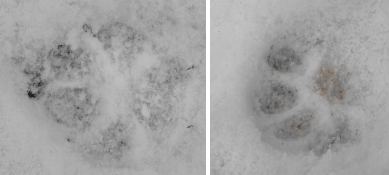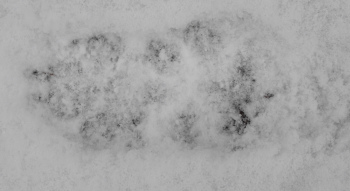
Farm Tracking 101, Part 2
Now that you can tell your
walkers from your bounders, let's take a look at two major walker
groups --- the canines and the felines. You'll have plenty of
opportunity to work on telling them apart when you track your household
pets, and the knowledge you'll gain there will carry over into figuring
out if a fox, bobcat, coyote, or mountain lion is lurking around
 your henhouse.
Basically, large or small, a cat is a cat and a dog is a dog.
your henhouse.
Basically, large or small, a cat is a cat and a dog is a dog.
One of each to get you
started. Which is a cat and which is a dog?
If you guessed dog on the left and cat on the right, you're
correct! The easiest way to tell a dog track from a cat track is
shape --- dog tracks are longer than they are wide while cat tracks are
about the same in both directions. I've noticed, though, that
when Lucy walks in really wet mud, her tracks can sometimes squish out
to look like cat tracks, so here are a few other helpful hints:
- Dog tracks often have visible claws (though not always.) Cat tracks don't.
- The main pad on a
cat track may show three lobes at the back (though as you can see
above, those lobes often aren't visible.) Dog tracks are less
visibly lobed, and there are only two lobes.
 If you find a track that you think is a
bobcat, it's often worth walking for a while in the animal's
footprints. Was the track you saw really just a domesticated dog
not showing its nails?
If you find a track that you think is a
bobcat, it's often worth walking for a while in the animal's
footprints. Was the track you saw really just a domesticated dog
not showing its nails?
For your homework, try to guess if the track to the right is a feline
or canine. Answers tomorrow!
| This post is part of our Farm Tracking 101 lunchtime series.
Read all of the entries: |
Want more in-depth information? Browse through our books.
Or explore more posts by date or by subject.
About us: Anna Hess and Mark Hamilton spent over a decade living self-sufficiently in the mountains of Virginia before moving north to start over from scratch in the foothills of Ohio. They've experimented with permaculture, no-till gardening, trailersteading, home-based microbusinesses and much more, writing about their adventures in both blogs and books.
Want to be notified when new comments are posted on this page? Click on the RSS button after you add a comment to subscribe to the comment feed, or simply check the box beside "email replies to me" while writing your comment.
